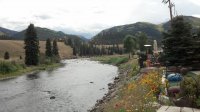- Posts: 6540
- Thank you received: 0
Severe trouble ahead, community suggestions to get through
- Martin Ent Inc
-

- Mountain Legend
-

Are preppers the new terrorists? FBI wants military surplus stores to spy on customers
Friday, August 12th, 2011 |What do you folks make of the flyer reproduced below?
It’s a new FBI handout that’s being distributed in that hotbed of potential terrorism, Colorado, USA according to a Wednesday Oath Keepers posting.
According to the FBI, if you value your privacy, that makes you suspicious. Or if you buy a lot of MREs (Meals, Ready-to-Eat) or stuff like weatherproofed ammunition or match containers or dangerous stuff like night vision devices, night flashlights, and gas masks. It’s good to know, though, that the FBI apparently thinks daytime flashlights are okay. After all, many of us do need flashlights to augment daytime sunlight so we can properly see.
And they do let you know that
Some of the activities, taken individually, could be innocent and must be examined by law enforcement professionals in a larger context to determine whether there is a basis to investigate. The activities outlined on this handout are by no means all-inclusive but have been compiled from a review of terrorist events over several years.
So on the one hand, they tell you that one of the listed activities by itself does not necessarily mean the person is a potential terrorist. On the other hand, they remind you that there are many other, undisclosed activities, that should be considered suspicious, thus encouraging us to report pretty much everyone so “law enforcement professionals” can examine them.
What I like best, though, is the fine print.
You know how advertisers often put the disclosures they hope you won’t read in small print at the bottom of the ad? I guess the FBI figured if it works for used car sales it can work for them.
Each indicator listed above, is by itself, lawful conduct or behavior and may also constitute the exercise of rights guaranteed by the U.S. Constitution. In addition, there may be a wholly innocent explanation for conduct or behavior that appears suspicious in nature. For this reason, no single indicator should be the sole basis for law enforcement action. The totality of behavioral indicators and other relevant circumstances should be evaluated when considering any law enforcement response or action.
Well, that’s good to know. Just buying some MREs probably won’t get me flagged. But if I buy a few cases of MREs, a weatherproof match container for camping, and pass over the daytime flashlights and buy one to use at night, in the dark, I should expect a visit from the feds to make sure I’m not up to something nefarious.
So…what do you think of this latest attempt by the feds to get us all spying on one-another?
Please Log in or Create an account to join the conversation.
- Local_Historian
-

- Mountain Legend
-

- Posts: 2321
- Thank you received: 1
Please Log in or Create an account to join the conversation.
- archer
-

- Mountain Legend
-

- Posts: 9964
- Thank you received: 8
Please Log in or Create an account to join the conversation.
- Martin Ent Inc
-

- Mountain Legend
-

- Posts: 6540
- Thank you received: 0
funny how easily people will fall to what the government wants them to believe.
Please Log in or Create an account to join the conversation.
- archer
-

- Mountain Legend
-

- Posts: 9964
- Thank you received: 8
Martin Ent Inc wrote: So what if one wants multiple items, geez they are made in china and are prone to fail so you need alot of them.
funny how easily people will fall to what the government wants them to believe.
Hey....just asking the questions. If a gun shop owner or sporting goods store clerk notices something not quite right, calls authorities and saves a lot of lives is that a bad thing? I don't see where that is what the government wants me to believe, that is just common sense. Something we could use a lot more of in this country.
Do you think the gun shop owner in Texas should have just minded his own business and not called the cops on the suspicious purchases by a dude who it turns out was targeting a local restaurant that is frequented by the military?
http://pajamasmedia.com/tatler/2011/07/ ... rist-plot/
Please Log in or Create an account to join the conversation.
- Residenttroll returns
-

- Mountain Legend
-

- Posts: 4630
- Thank you received: 0
Please Log in or Create an account to join the conversation.
- ScienceChic
-

- Mountain Champion
-

- Posts: 15745
- Thank you received: 320
http://transitionus.org/transition-town-movement
The Transition Town Movement
The Transition Movement is comprised of vibrant, grassroots community initiatives that seek to build community resilience in the face of such challenges as peak oil, climate change and the economic crisis. Transition Initiatives differentiate themselves from other sustainability and "environmental" groups by seeking to mitigate these converging global crises by engaging their communities in home-grown, citizen-led education, action, and multi-stakeholder planning to increase local self reliance and resilience. They succeed by regeneratively using their local assets, innovating, networking, collaborating, replicating proven strategies, and respecting the deep patterns of nature and diverse cultures in their place. Transition Initiatives work with deliberation and good cheer to create a fulfilling and inspiring local way of life that can withstand the shocks of rapidly shifting global systems.
It all starts off when a small collection of motivated individuals within a community come together with a shared concern: How can our community respond to the challenges and opportunities of peak oil, climate change and the economic crisis?
The Transition Model, as outlined in the Transition Handbook, provides a framework which includes the following:
Guiding Principles
Guidelines
"12 Ingredients"
"7 Buts"
Scales
During the process the community recognizes these two crucial points:
That we used immense amounts of creativity, ingenuity and adaptability on the way up the energy upslope, and there's no reason for us not to do the same on the downslope.
If we collectively plan and act early enough, we can create a way of living that's significantly more connected, more vibrant and more fulfilling than the one we find ourselves in today.
http://transitionus.org/why-transition
Why Transition?
The Transition model is based on a loose set of real world principles and practices that have been built up over time through experimentation and observation of communities as they drive forward to reduce carbon emissions and build community resilience. Underpinning the model is a recognition of the following:
Peak Oil, Climate Change and the Economic Crisis require urgent action
Adaptation to a world with less oil is inevitable
It is better to plan and be prepared, than be taken by surprise
Industrial society has lost the resilience to be able to cope with shocks to its systems
We have to act together and we have to act now
We must negotiate our way down from the “peak” using all our skill, ingenuity and intelligence
Using our creativity and cooperation to unleash the collective genius within our local communities will lead to a more abundant, connected and healthier future for all.
The Transition Movement believes that is up to us in our local communities to step into a leadership position on this situation.
"Now, more than ever, the illusions of division threaten our very existence. We all know the truth: more connects us than separates us. But in times of crisis the wise build bridges, while the foolish build barriers. We must find a way to look after one another as if we were one single tribe.” -King T'Challa, Black Panther
The truth is incontrovertible. Malice may attack it. ignorance may deride it, but in the end, there it is. ~Winston Churchill
Please Log in or Create an account to join the conversation.
- AspenValley
-

- Mountain Legend
-

- Posts: 1955
- Thank you received: 0
Adapt or die.
Please Log in or Create an account to join the conversation.
- homeagain
-

- Mountain Legend
-

- Posts: 12553
- Thank you received: 173
insight on possible scenarios and solutions. Another book that has been on my shelve for a very long time......EARTHKNACK Stoneage
Skills for the 21st century by Bart and Robin Blankenship. Preparation and proactiveness is a trait well cultivated.....very hard to accomplish in a reactive nation.JMO
Please Log in or Create an account to join the conversation.
- HEARTLESS
-

- User is blocked
-

- Posts: 4316
- Thank you received: 30
That was weird, try spelling lol lipops and see what comes up.
The silent majority will be silent no more.
Please Log in or Create an account to join the conversation.





